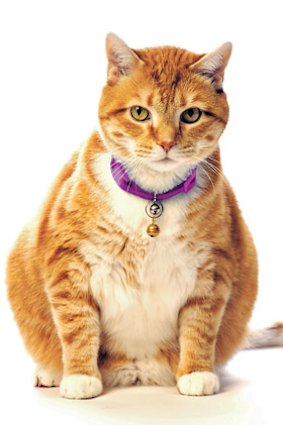This was published 11 years ago
Fat boy slims
Overweight pets can suffer from diabetes and arthritis, so if you really love them, put them on a diet, writes Lissa Christopher.
The fattest cat that veterinarian Anne Fawcett has treated weighed 18 kilos. His diet compromised a mouth-watering selection from the table of his doting Italian owners, including lasagne, pasta and marinated chops.
He was too lardy to participate in every cat's favourite pastime - cleaning his own backside - and had to be sponged down daily. It was amazing that he hadn't developed diabetes, says Fawcett, who consults at Sydney Animal Hospitals - Inner West.

30% of Australian cats are overweight or obese.
That cat is an extreme example but overweight pets, like overweight humans, are easy to find.
Several years ago, Fawcett was part of a research team led by Professor Paul McGreevy from the University of Sydney that found that about 40 per cent of dogs and 30 per cent of cats were overweight or obese. And once an animal becomes overweight, it's difficult to slim them down again, Fawcett says. This has little to do with their metabolism and a lot to do with their owners.
''Our biggest challenge is helping owners cope with restricting the intake of their pets,'' Fawcett says.
''We humans are easily manipulated and our animals have us trained. They know that if they give us a high-pitched meow or those sad puppy eyes, we will eventually go back to the cupboard.''
Our human heart strings, it seems, are the reason many animals get fat in the first place.
''People have trouble separating food from love,'' Fawcett says. ''Their dog or cat seems happy when it's fed, so people think they're giving them affection. And that's the tragedy.
''I understand that people want to adore and spoil their pets. I get it. I'm the same. But it's a sort of false happiness you're providing if you are overfeeding them because you will ultimately subject them to a lot of unhappiness.''
That unhappiness includes diabetes and arthritis.
Managing diabetes usually means two insulin injections, 12 hours apart, every day, Fawcett says. ''So the owners are really tied down. And with diabetes, the animals are also more prone to secondary infections. Prevention is preferable.''
While a single kilogram of excess weight might be next to nothing to a human, ''that can be a huge extra load on the joints of a small dog,'' Fawcett says. ''And arthritis is one of the most common reasons we have to put geriatric animals to sleep. In severe cases, they can get to a stage where they can't move. They are in a lot of pain. The pain relief isn't adequate. They can't clean themselves. They can't go to the toilet. It's really not humane.
''Weight loss is the key to managing the pain of arthritis and reducing its progression.''
There are some medical conditions that can cause animals to put on weight, such as hypothyroidism and certain brain tumours, but it's mostly just about calories in and calories out, Fawcett says. As such, weight loss for pets comes down to eating less and moving more.
It is, however, critically important with animals, especially cats, to take it slowly.
''If you put a cat on a crash diet, they can go into liver failure,'' Fawcett says.
As for increasing their movement: with dogs, it's fairly obvious, but with cats, you may need to get more creative (see tips).
''There's a myth that cats can't or won't exercise but that's not true,'' Fawcett says.
For the record, that 18-kilogram cat quit the lasagne, lost several kilograms, and is still going strong.
Exercise for the reluctant cat
+ Keep your cat awake
(yes, really).
+''Even if you just bat a ball of paper around the room and the cat won't budge, its eyes will widen, which means it's awake, it's turning its head a bit, it's burning calories and it will lose weight,'' Fawcett says. ''It's just a matter of persisting.''
+ Make your cat follow its food bowl around the room a few times before setting it down. ''One for highly food-motivated cats,'' Fawcett says.
+ Put the cat in an empty bath tub and drop in a ping-pong ball. ''As one of my colleagues says, it's like roller derby for cats,'' Fawcett says.
+ Buy a laser pointer and get your cat chasing the dot. But don't point it at the cat.